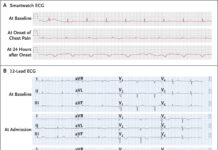Double vision and “bubbly appearance” of left eye, patient diagnosed with orbital emphysema
After falling and hitting his face on a concrete floor, a 63-year-old man arrived to the emergency room with a 1-day history of double vision and a “bubbly appearance” of the left eye. Doctors diagnosed the patient with orbital emphysema. Air bubbles were discovered during a physical examination of the left eye (Panel A), in addition to periorbital edoema, crepitus of the upper and lower eyelids, and a restriction of the left side’s lateral, upward, and downward eye movements. The left eye’s visual acuity was 20/400, and the intraocular pressure (reference range, 12 to 20 mm Hg) was 25 mm Hg. An examination of the right eye produced normal results.
The face’s computed tomography revealed fractures of the inferior orbital rim, retrobulbar and periorbital subcutaneous emphysema (Panel B, asterisks), as well as an intact globe on the left side. Traumatic orbital emphysema was identified as the cause. When an orbital fracture permits air to enter the orbit via a sinus, traumatic orbital emphysema develops. In the event of an orbital fracture, the globe should be carefully examined for injury. Doctors further performed a conjunctiva decompression. The patient’s visual acuity increased to 20/200 after the surgery. The patient was prescribed to take brimonidine, a topical antibiotic, and eye lubricant before being released. However, the patient did not return for follow-up.
Classification
Heerfordt wrote the first comprehensive description of orbital emphysema, which was published in 1904. He classified the condition as: palpebral emphysema, true orbital emphysema, and orbitopalpebral emphysema. It is rare to have isolated palpebral emphysema, which is subcutaneous air only present in the eyelids. A fracture of the lacrimal bone and subsequent rupture of the lacrimal sac anterior to the orbital septum may cause palpebral emphysema. The nasolacrimal drainage system allows air from the nose to pass through and enter the tissues of the eyelids. Palpebral emphysema can also develop as a result of subcutaneous air from the face moving through fascial planes into the eyelids. Air should stay contained to the lid as long as the orbital septum is intact.
An aberrant accumulation of air posterior to an intact orbital septum characterises true orbital emphysema. The most frequent causes of the condition are fractures of one or more of the bony orbital walls and laceration of the mucosa of the nearby sinus, which allow connection between a sinus and the orbit. This fracture frequently entails a rupture of the delicate lamina papyracea and ethmoid air cells. Orbital emphysema is a less common complication of fractures of the frontal, sphenoid, and maxillary sinuses. Notably, air does not enter the orbit spontaneously after the fracture but rather does so on occasion when the pressure in the upper respiratory passages is raised (for instance, when sneezing or blowing one’s nose).
If there is a break in the orbital septum, orbitopalpebral emphysema may develop. The pressure inside the orbit rises as air builds up there. Eventually, the orbital septum may burst, allowing air to easily pass from the orbit into the eyelids. Heerfordt discovered that the septum must break at a mean intraorbital pressure of 40 to 50 mm Hg by experimentally injecting air into cadavers. The orbital septum gets increasingly attenuated with ageing, and the cadavers of older individuals required considerably lower mean pressures to tear it than did the cadavers of younger people.
Summary
Orbital emphysema is the presence of air within the orbital or eyelid tissues. Trauma is the most common cause, but other factors, such as infections, may also contribute to the disease. Eye movement restriction, double vision, proptosis, or enophthalmos are some of the symptoms. The effects can result in irreversible visual loss in rare situations. To diagnose orbital emphysema, doctors employ palpation, which involves checking the area with the hands, and a CT scan. In most situations, no treatment is required, but more serious cases may necessitate needle air drainage or orbital reconstructive surgery. If you have symptoms of orbital emphysema, seek medical assistance right away because early treatment can prevent visual loss.
Source: NEJM




